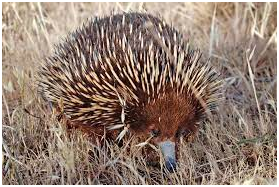Short-Beaked Echidnas
News: According to Curtin University researchers, short-beaked echidnas in Western Australia beat the heat by spouting bubbles of mucus.
The short-beaked echidna is one of the four varieties still in existence.
It has a peculiar snout, a tongue with particular adaptations, is covered in hair and spines, and all of these features help it catch its insect prey (such as termites and ants) quickly.
The front limbs and claws of the short-beaked echidna are incredibly strong, enabling it to burrow fast and powerfully.
It has a significant tolerance to high amounts of carbon dioxide and low levels of oxygen since it must be able to survive underground.
Instead of fighting or using weapons, it curls into a ball and uses its spines to fend off predators.
Due to its inability to sweat and poor heat tolerance, it tends to avoid outdoor activities throughout the day while it’s hot outside.
If necessary, it can swim.
Mechanoreceptors and electroreceptors on the snout enable the echidna to sense its environment.




